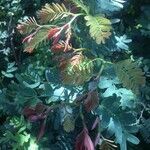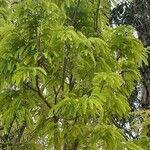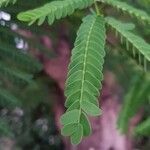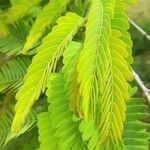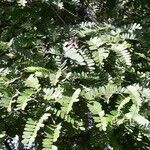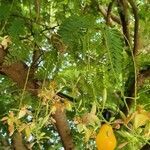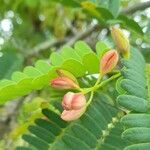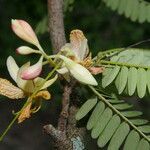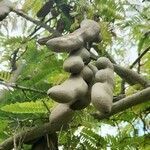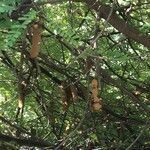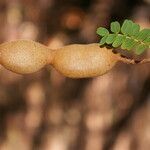Tree up to 20 m high with a somewhat rounded crown. Bark rough, grey, brown or greyish-black; young branchlets pubescent or puberulous. Leaves: petiole 0.4-0.8 cm long, subglabrous to ± pubescent; rhachis 4.5-12 cm long (in our area), subglabrous to ± pubescent; leaflets in 10-18 opposite pairs (in our area), oblong, (0.8)1.2-2.5 cm long, 0.3-1 cm wide (in our area), asymmetric basally, rounded to rounded-subtruncate apically, seldom slightly emarginate, glabrous throughout or with a basal tuft of hairs on the lower surface to one side of the midrib, sometimes (but not in our area) pubescent on midrib and margins or all over both surfaces, venation reticulate, ± raised and conspicuous on both surfaces. Racemes 1-15 cm long; axes subglabrous to densely pubescent. Flowers red in bud, on glabrous to pubescent pedicels 3-14 mm long. Hypanthium 3-5 mm long. Sepals 8-12 mm long, pale yellow inside, reddish outside, pubescent basally within. Petals: upper larger three 10-13 mm long, elliptic or obovate-elliptic, yellow with red veins. Ovary ±6 mm long, pubescent. Pods brown, (3)6.5-14 cm long, 1.5-3 cm in diameter, curved or sometimes ± straight, sausage-like, usually obtuse basally and apically, margins sometimes irregularly constricted, closely covered outside with small brown scales, indehiscent. Seeds chestnut-brown, ± rhombic to trapeziform, 11-17 mm long, 10-12 mm wide.
Tree 3–24 m. high; bark rough, grey or grey-black; crown rounded; young branchlets pubescent or puberulous.. Leaves: petiole with rhachis 5–12(–16) cm. long, ± pubescent; leaflets in 10–18(–21, fide F.C.B.) pairs, narrowly oblong, (0.8–)1.2–3.2 cm. long, 0.3–1.1 cm. wide, rounded to rounded-subtruncate rarely slightly emarginate at apex, rounded and asymmetric at base, glabrous except for a tuft of yellowish hairs at base, sometimes pubescent up midrib and margins, rarely all over both surfaces; venation ± reticulate-raised on both surfaces.. Racemes 1–15(–22) cm. long; axis subglabrous to densely pubescent; pedicels 3–14 mm. long, glabrous to pubescent.. Flower-buds red.. Hypanthium 3–5 mm. long.. Sepals 8–12 mm. long, pale yellow inside, reddish outside.. Large petals 10–13 mm. long, elliptic or obovate-elliptic, gold with red veins.. Pods curved or sometimes straight, sausage-like, (3–)6.5–14 cm. long, 2–3 cm. in diameter, usually obtuse at base and apex, sometimes irregularly constricted, closely covered outside with brown scurf, 1–10-seeded.. Seeds chestnut-brown, ± rhombic to trapeziform, 11–17 mm. long, 10–12 mm. wide.. Fig. 32.
A large spreading tree up to 24 m tall. It has a broad dense evergreen crown. In dry areas the tree can lose its leaves. The trunk can be 1 m across. The bark is rough and grey with a checkered pattern. The leaves are carried one after another along the branch. The whole leaf is 6-12 cm long and it is divided into 10-17 pairs of leaflets. These are oblong and without stalks. The whole leaf has a leaf stalk about 15 cm long. The leaflets are 1-2.5 cm long and 4 9 mm wide. They are a dull dark green and with a rounded tip. The flowers are pale yellow with brown markings. The flowers are about 2.5 cm across and hang on long many flowered stalks. The fruit is an oblong thin skinned fleshy capsule. The brown seeds are inside this long rough surfaced, sausage-like fruit. This pod is 6-8 cm long and about 2 cm wide and contracted between the seeds. The pod cracks when mature. It is a legume. The pulp is date like and reddish brown. The seeds are shiny and hard. The pulp of the pods is edible.
Trees, 10-15(-25) m tall. Trunk 30-50(-90) cm d.b.h. Bark dark ashy, irregularly longitudinally splitting. Leaflets oblong, small, 1.3-2.8 cm × 5-9 mm, glabrous, base obliquely rounded, apex rounded or emarginate. Flowers few, yellowish tinged with purplish red stripes; peduncles and pedicels yellowish green puberulent; bracteoles 2, ca. 1 cm, enclosing flower bud before anthesis. Calyx tube ca. 7 mm; lobes lanceolate-oblong, ca. 1.2 cm, reflexed after anthesis. Petals obovate, subequal to calyx lobes, margin repand, curled. Stamens 1.2-1.5 cm, pubescent near base, free parts of filaments ca. 7 mm; anthers elliptic, ca. 2.5 mm. Ovary slightly incurved, terete, ca. 8 mm, hairy. Legume brownish, straight or arcuate, terete-oblong, turgid, 5-14 cm, often irregularly constricted. Seeds 3-14, brownish, shiny. Fl. May-Aug, fr. Dec-May. 2n = 24, 26, 28*.
Tree to 20 m tall. Leaves: petiole 4-8 mm long; rachis 4.5-12 cm long; leaflets in 10-18 pairs, oblong, 0.8-2.5 cm long, 3-10 mm wide, mostly rounded to rounded-subtruncate apically, glabrous throughout or with a basal tuft of hairs on lower surface, or sometimes pubescent on midrib and margins or throughout; venation conspicuous. Racemes 1-15 cm long. Flowers red in bud. Hypanthium 3-5 mm long. Sepals 8-12 mm long, pubescent basally within. Petals: upper larger three 10-13 mm long, elliptic or obovate-elliptic, yellow with red veins. Pod subcylindric, curved or straight, mostly 6.5-14 cm long, 1.5-3 cm in diam., closely covered with small, brown scales; margins sometimes irregularly constricted. Seeds ±rhombic to trapeziform, 11-17 mm long, 10-12 mm wide, chestnut brown.
Unarmed, naturalized trees, with puberulent to glabrous branchlets, spreading crown, and rough, brown bark. Leaves 6-12 cm. long, glabrous or nearly so; leaflets 6-18 pairs, oblong, 1-2.5 cm. long, rounded to retuse apically, obliquely obtuse to subtruncate basally, chartaceous, reticulate. Inflorescence as described for the genus; pedicels slender, 6-10 mm. long. Flowers yellow striped with red; sepals 5, elliptic-lanceolate, 6-10 mm. long; larger petals 3, obovate, 8-12 mm. long, subfimbriate; stamens arcuate, investing the ovary below, up to 14 mm. long; anthers oblong, about 2 mm. long; ovary somewhat pubescent basally. Legume 5-15 cm. long, about 2 cm. thick, lepidote, with an acid pulp surrounding the seeds; seeds about 1 cm. wide.
Leaves: stipules free, narrowly ovate, small, early caducous; petiole with rachis 5–12(16) cm long, pubescent; leaflets in 10–18 pairs, (0.8)1.2–3.2 cm long, narrowly oblong, rounded and asymmetric at the base, rounded to truncate or sometimes emarginate at the apex, pubescent or occasionally glabrous except for a tuft of yellowish hairs at the base, venation raised-reticulate on both surfaces.
Pods 3–14 cm long, 2–3 cm in diameter, cylindrical with irregular constrictions, straight or curved, brown-scurfy, 1–10-seeded.
Racemes 1–15(22) cm long; axis pubescent to densely so; pedicels 3–14 mm long, glabrous to pubescent.
Petals yellow with red veins, large ones 10–13 mm long, elliptic to obovate-elliptic.
Sepals pale yellow inside, reddish outside, 8–12 mm long, elliptic, acute, imbricate.
Seeds chestnut-brown, 11–17 × 10–12 mm, rhombic to trapezioid.
Tree to 25 m; crown rounded; bark rough, grey or grey-black.
Young branchlets pubescent to puberulous.
Hypanthium 3–5 mm long.
Flower buds red.
